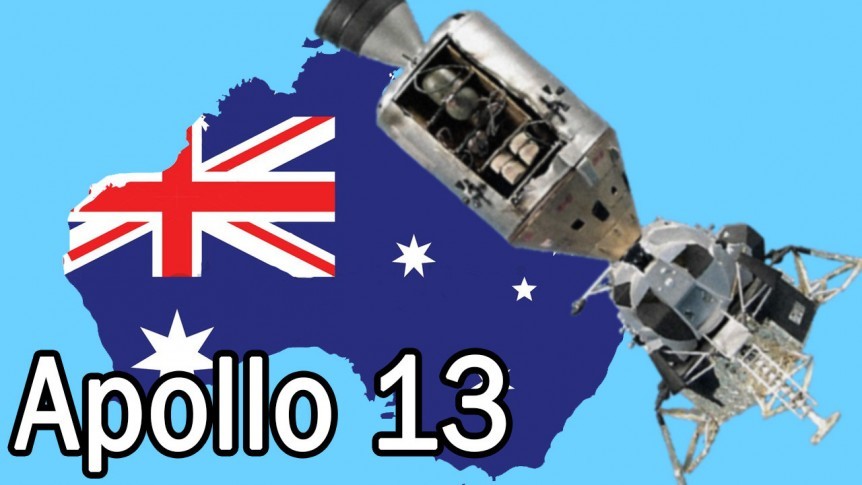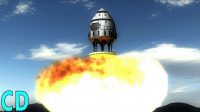When you mention the words “Apollo” and “NASA” most people will immediately think of America, that big U.. S.. A.. on the side of the Saturn V rockets at take off is an awe inspiring sight and a great piece of national branding but success in Space requires a global effort: the International Space Station is only the latest example of the coordinated ingenuity of nations working together to get things done off the planet.
The problem with space craft is that they don’t stay above the launch area, they orbit the earth about 16 times a day and the earth is rotating too, so you need transmitters and receivers spread around the world if you are to keep in constant contact.
In the 1960s, America set up a worldwide communications network to support the Mercury Space Program. To maintain communication with astronauts in orbit, NASA needed radio dishes far beyond American borders. Unlike the Soviet Union, whose land crossed eleven time-zones and very high latitudes, the United States relied on foreign bases to form the MSFN (pronounced ‘Mis-fin’), or ‘Manned Space Flight Network’.
This network was made up of nine ground stations and two ships: one in the Indian Ocean, and one in the Pacific. Spacecraft would communicate through successive stations as they orbited around the earth, maintaining relay connection with ground control. By 1963, the network was up and running, and allowed them to keep in contact with Gordon Cooper’s Mercury flight as it made make 22 orbits of the planet: a journey of 546,167 miles, or 878,971 kilometres, more than all America’s previous manned missions combined.
By 1965 NASA was preparing the communications network for Apollo’s daring reach for the Moon. Three 26-metre (85 foot) dishes were planned to allow reliable communication with the distant Service Module and Lunar Lander.
One of these new facilities was in Honeysuckle Creek, a 14-acre radio quite area surrounded by granite peaks of the Australian Alps, 32km, 20 miles SSW of Canberra, New South Wales in Australia. Construction was completed in 1967, and in 1969, the station had the honour of relaying the video signal of Neil Armstrong’s first steps on the lunar surface.
But the team faced their greatest challenge in 1970 when disaster struck aboard the Apollo 13 mission. During a routine operation, one of the cryogenic oxygen tanks malfunctioned and exploded, leaving the astronauts with no choice but to retreat into the lightweight Lunar Module as a lifeboat. To make matters worse, the main antenna of the spacecraft was damaged by the explosion. Astronauts Lovell, Swigert and Haise could only talk to ground control through the smaller antenna on the lunar module.
Despite its modern specification, Honeysuckle Creek struggled to pick up the faint radio signal from Apollo 13’s Lunar module. Fortunately, the Australian team had a solution only 350 kilometres or 220 miles North: the Parkes radio observatory. This was a 64-metre or 210-foot dish: a powerful, moveable antenna.
Although Parkes had been used to communicate with Apollo 11 on the lunar surface, the plan to use a deployable ‘umbrella’ antenna on the Moon meant that the facility was not configured to talk to Apollo 13, and was instead doing routine astronomical observations.
Converting the dish to communicate with a near-Earth target would usually take a week: but every hour was a battle for survival for the stricken Apollo crew. A team of engineers were urgently flown to Parkes, and worked around the clock to reconfigure the dish in a single day.
Even with the giant antenna pointed at the Moon, the signal from the Lunar Module was proving difficult to detect. Apollo 13’s Saturn (4B) IV-B upper stage was transmitting telemetry data on the same frequency which was interfering with the crew’s voice communications. The Lunar Module would normally have been powered up only AFTER the Saturn upper stage had crashed into the Moon and stopped transmitting. However, with the astronauts relying on the Lunar Module’s antenna, the Australian operators had to identify and filter out the unwanted signal.
Still unable to hear the crew’s transmissions, ground control sent a message for the astronauts to turn off their transponder, and wait in silence for the Parkes team to isolate the Saturn 4B signal. When the crew switched on their radio again, the operators were able to lock onto the crew’s voice transmission, and guide the Apollo 13 team to patch together their ailing spacecraft.
Three days later, when the crew arrived safely back on Earth, the Australian engineers and radio operators were deservedly credited for their part in the rescue.
In 1981 operations at the Honeysuckle Creek station came to an end, as a new generation of the ‘Deep Space Network’ came online: with a station nearby in Tidbinbilla. The updated 70-metre dishes were modelled on the successful Parkes design: a legacy that serves international work in space to this day.
So thanks for watching, I just like to say this episodes shirt was the Zig Zag Trip by Madcap England and is available at AtomRetro.com with worldwide shipping from the UK.






Comments
Awesome and fascinating story… thanks for sharing that!